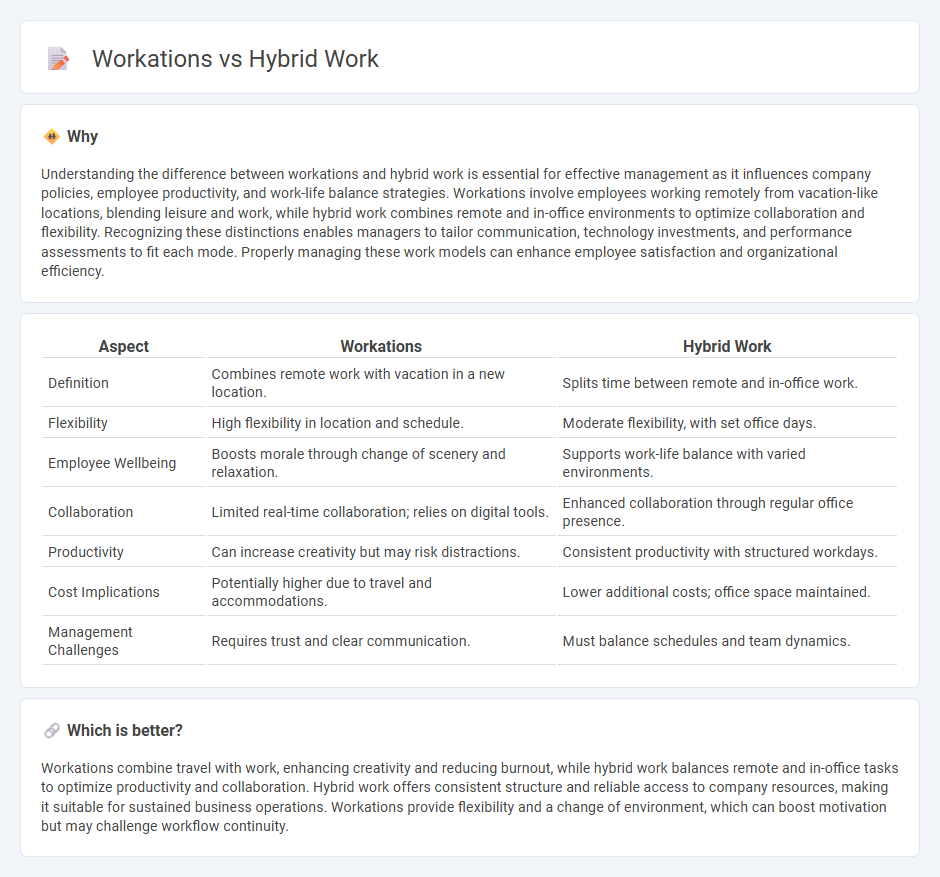
Workations combine remote work with travel, offering employees a change of environment to boost creativity and reduce burnout while maintaining productivity. Hybrid work blends in-office and remote schedules, enhancing flexibility and collaboration within teams. Explore how workations and hybrid models can transform your management strategy for greater employee satisfaction and performance.
Why it is important
Understanding the difference between workations and hybrid work is essential for effective management as it influences company policies, employee productivity, and work-life balance strategies. Workations involve employees working remotely from vacation-like locations, blending leisure and work, while hybrid work combines remote and in-office environments to optimize collaboration and flexibility. Recognizing these distinctions enables managers to tailor communication, technology investments, and performance assessments to fit each mode. Properly managing these work models can enhance employee satisfaction and organizational efficiency.
Comparison Table
| Aspect | Workations | Hybrid Work |
|---|---|---|
| Definition | Combines remote work with vacation in a new location. | Splits time between remote and in-office work. |
| Flexibility | High flexibility in location and schedule. | Moderate flexibility, with set office days. |
| Employee Wellbeing | Boosts morale through change of scenery and relaxation. | Supports work-life balance with varied environments. |
| Collaboration | Limited real-time collaboration; relies on digital tools. | Enhanced collaboration through regular office presence. |
| Productivity | Can increase creativity but may risk distractions. | Consistent productivity with structured workdays. |
| Cost Implications | Potentially higher due to travel and accommodations. | Lower additional costs; office space maintained. |
| Management Challenges | Requires trust and clear communication. | Must balance schedules and team dynamics. |
Which is better?
Workations combine travel with work, enhancing creativity and reducing burnout, while hybrid work balances remote and in-office tasks to optimize productivity and collaboration. Hybrid work offers consistent structure and reliable access to company resources, making it suitable for sustained business operations. Workations provide flexibility and a change of environment, which can boost motivation but may challenge workflow continuity.
Connection
Workations integrate remote work with travel, enhancing employee flexibility and well-being, which complements hybrid work models that blend office and remote environments to optimize productivity. Management strategies focus on balancing work-life integration through policies that support both workations and hybrid schedules, ensuring consistent communication, collaboration, and performance tracking. Data shows organizations adopting these flexible work arrangements report higher employee engagement and retention rates.
Key Terms
Flexibility
Hybrid work offers employees the flexibility to alternate between remote and in-office environments, optimizing productivity and work-life balance. Workations combine travel and work, allowing professionals to perform job tasks while exploring new locations, thus enhancing creativity and reducing burnout. Discover how these flexible work models can transform your professional and personal life.
Productivity
Hybrid work models blend remote and on-site tasks, enhancing productivity by offering flexibility and reducing commute-related stress. Workations combine work with travel, potentially boosting creativity but requiring strong time management to maintain productivity. Discover how these approaches influence efficiency and employee satisfaction further.
Employee Engagement
Hybrid work models enhance employee engagement by balancing remote flexibility with in-office collaboration, fostering stronger team dynamics and productivity. Workations combine work and vacation, offering employees a refreshing environment that can boost creativity, motivation, and overall job satisfaction. Explore how these evolving work trends can transform your organization's employee engagement strategies.
Source and External Links
What is hybrid work and what are hybrid work models? - Webex - Hybrid work is a flexible model that blends in-office, remote, and on-the-go work, giving employees the autonomy to choose where and how they work most effectively.
What Is Hybrid Work? - Cisco - Hybrid work emerged as a mainstream model during the COVID-19 pandemic, offering benefits like increased flexibility, reduced commute times, and lower real estate costs for companies.
Hybrid Still Isn't Working - Harvard Business Review - Despite its popularity, some evidence suggests hybrid work may hurt collaboration, increase social isolation, and weaken organizational culture.
 dowidth.com
dowidth.com